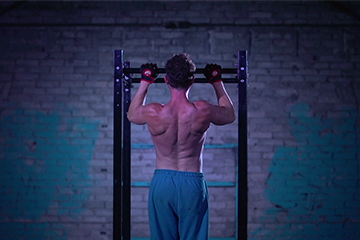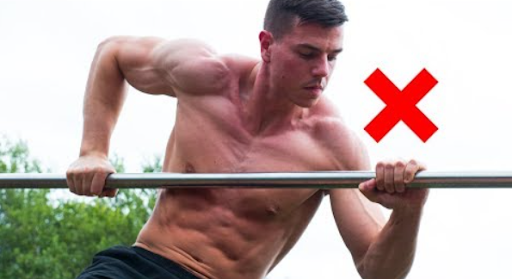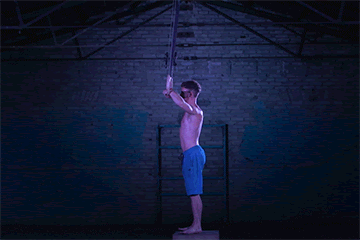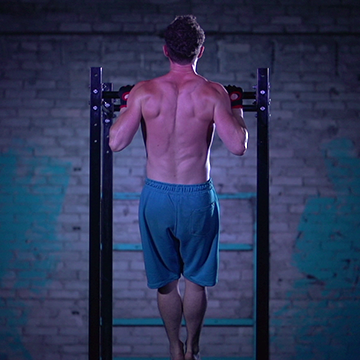🔎Are you struggling to do muscle-ups? Do you feel like you’re close, but just can’t seem to make the jump?🥺 In this blog post, we will discuss how to improve your muscle-ups. We will provide tips and tricks that will help you make the most of this challenging exercise.
In this article, we’ll be covering these topics about the muscle-up:👇
- 🎯 What does a STRICT & PROPER muscle-up look like
- 🎯 Common mistakes
- 🎯 5 ways how to improve your muscle-up
- 🎯 & a muscle-up workout you can follow
Stay tuned for more information!
💯5 Ways How to Improve Muscle Up💯
What got you into calisthenics? Was it wanting to learn a handstand? Did you see pistol squats and think, man, I wanna do that!? Maybe front & back levers turn you on…
There’s one move that leaves those for dust thanks to its iconic status and ego-flattering properties: the muscle-up!
Who knew the combo of a pull-up and a dip could be so known across the world and so sought after?!😲
You love the muscle-up because you know it’s doable; it’s not going to take years to achieve like an iron cross or planche. You know you can go on YouTube and find thousands of tutorials and how-to guides on muscle-up. You also know a park with a high bar or a gym where you could have a crack at what’s often called ‘the upper body squat’.
You think you can muscle up but can you actually?
What is a muscle-up?🤔
Before we can start giving your muscle-ups a makeover we must define what a muscle-up means in the context of this post, and what it means in your head. You can either do things right or do them wrong and to do them wrong is simply a waste of the most precious thing you have, and will ever have…time.
While muscle-ups are still a rare sight, (think about how many you’ve seen in real life, not on a video), there are plenty of people who can do anywhere from 1-5 ‘muscle ups’. We’ll call them muscle-ups because they’re getting from a pull-up into a dip and back again. That’s it, right?
If a muscle up in any sense of the word is rare, how are STRICT muscle-ups? A clean/strict/proper muscle-up is not only a sight of beauty to behold but also a feat of serious athleticism. You can learn a lot about someone who can strict muscle-up. We know they have the following:
- ✅ They have well above average vertical (pull up) strength
- ✅ They have well above average vertical (dipping) strength
- ✅ They have strong, stable & functional shoulders
- ✅ Their muscular chain(s) work very well as muscle-ups require tension from head to toe
- ✅ They have the skillset to combine velocity with coordination
Do you break the rules? If you want to get to the next level and become the athlete you’ve always wanted and not only turn the heads of the layman but also those who’ve been in the game for years, you’re going to need to clean your muscle-ups up. Even if you have strict muscle-ups, there are always ways to improve them…..you just may not know-how. An example of strict muscle-ups can be seen below.
Here is a super useful video breaking down all the technique you need for muscle up:
🤜You’re not sure if you’re strict or non-strict? Let’s now dissect the non-strict muscle up by outlining all of its offenses:
⚡️KIPPING OR USING MOMENTUM
Easily identified; do you bend your legs to any degree as you pull up through the transition? Although often subtle, this makes a difference as the knee drive creates extra inertia that catapults you through the most challenging portion of the move, the transition. You may think you’re a badass blasting out kipped muscle ups but with this technique, your transitional strength will be almost non-existent.
Not only will you blunt your development in the transition but your raw pulling power will suffer as your body simply doesn’t need to pull higher, because your knee drive does the job.
Read here more on Kipping vs Strict Pull-ups
⚡️‘CHICKEN WINGING’/ BOTH ARMS AREN’T ROTATING AT THE SAME TIME
Similar to kipping, uneven arms in a muscle up can be subtle or pronounced. Either way, this is a must avoid. The detriments of this go beyond aesthetics and instead become an issue of safety. If you value your shoulders and elbows, this is one to not even start let alone eradicate. Needless to say, when one arm goes up before the over, serious force is sent through the shoulder and elbow joint. Usually, people who commit this offense don’t have strong enough rotator cuffs and tendons to withstand it.

Not going all the way down every rep.
⚡️BEING A ‘HALF-REPPER’ / NOT USING A FULL RANGE OF MOTION
Half reps, half results is my motto with clients and it’s one you can take to any move you like! If you shouldn’t half rep your pull-ups or dips, what makes you think muscle-ups are an exception? Just because they’re harder that makes it OK?
Initiating the move with bent arms leaves lots of scapula strength gains on the table. The great quality of calisthenics is how much crossover there is between moves and why not use this knowledge to our advantage with muscle-ups?
“Muscle-ups are overrated. They don’t do anything that a pull-up or dip can do individually.” Is a line I’ve heard in movement circles and nearly always the person saying this isn’t referring to a high-quality muscle-up. The pulling power built-in high-quality muscle-ups have wonderful carryover to moves like the front lever!
⚡️COMMON HALF-REP MISTAKE!
A less common example of half-repping with regards to the muscle-up comes with ring muscle-ups; how many times do you see people not pressing the dip out to a full turnout and thus, missing out on the elbow strengthening benefits of what’s known as the ‘RTO’ support position?
If time is precious, why waste it? Why spend so much time doing it wrong to have to invest MORE time putting it right in the form of boring isolation exercises, because you’ve developed glaring imbalances that are now literally stopping you from making any progress? Use the largest range of motion you have safely available to you.
☝️ THE MEDICINE
We’ll now go over the best training methods to eliminate these faults one by one so you can get your muscle-ups on the road to the next level.
✊ FIXING THE KIP WITH BANDS AND HIGH PULL-UPS
When I was looking to rebuild my muscle-up I followed a simple method: I would do 3 sets of 3 explosive pull-ups at the beginning of EVERY workout, while I was fresh. I made these pull-ups as similar to the muscle-up pull technique as possible – I had a hollow body, and I would swing forward just in front of the bar, keep a slight ‘false’ grip and pull as high as possible. Usually, this was around ribcage height.
The key isn’t to worry about exactly how high you pull, but more that you’re improving over time. I would give myself full recovery which meant a good 3 minutes or so rest.
Once you’ve done 3 sets of 3 high pull-ups it’s time to move on to banded muscle-ups. Choose a band with generous resistance; there are no points here for struggling. Struggling will build bad patterns. The purpose of the banded work is to groove the correct pattern of the muscle-up. You can’t do this if the assistance is too light or you’ll revert back to those ghastly kipping ways.
3 sets of 3-5 reps work well here. Again, keep the rest generous so you can sustain the quality.
✊ THROWING OUT THE CHICKEN WINGS WITH NEGATIVES
You don’t like negatives because they’re not much fun, I get it. But sometimes what we need most isn’t what we want most. Eccentric muscle-ups work very well for grooving the true motion/technique through the trickiest part, the transition.
The reason you and I find eccentric training tough is because the ego hates not doing the full move. The ego seeks instant gratification. If you pair eccentric work with other intelligent and effective moves, all of a sudden the puzzle starts forming, and before you know it you’re back doing better muscle ups than ever before!
Eccentric work is stressful to the body because you’re technically using loads greater than you can handle concentrically (the positive phase of a lift; going up instead of down). For this reason, we want to keep the volume low…5 sets of 1 rep as slow and as perfect as you can go is the ticket here.
✊ USE ISOMETRIC PAUSES TO IMPROVE YOUR RANGE & NOT BE A HALF REPPER
Solutions 2 and 3 are very interchangeable and each could be used to fix the other. One of the simplest ways to force someone to use a better/stricter form is to introduce pauses in challenging places throughout the range of motion. The protocol I’m about to share with you not only helps you get strong at the extremes of the range but also greatly aids your transitional strength!
HOW TO IMPLEMENT PAUSES⏳
You’ll separate pull-ups and dips (bar or rings) into individual sets and incorporate 3-second holds at both the top and bottom. For the pull-ups, this means pausing in an active hang (shoulders pulled down & back with the arms locked) for 3 seconds, pulling up powerfully, and holding the top position as high as you physically can. If you can get chest-to-bar contact and hold it, then rock that shit! If not, keep working on it and it WILL improve.
When it comes to dips, regardless of straight bar or rings, lower down as low as you can actively control – which means your muscles are still working, NOT resting your chest on the bar or just resting on your joints at the bottom of a ring dip! Pause for an honest 3 count and then explosively press back out. If you’re doing straight bar dips make sure you drive your shoulders down as much as possible (scapula depression) and have locked arms.
🔥Ring muscle-up
If you’re using rings, this will mean turning the rings out as much as you can and holding them for 3 seconds. Don’t worry if you’re only turning the rings out to a neutral position initially, just ensure you’re locking the arms and driving the shoulders down. It’s not full range if you’re not.💯
👊Extra tips to really make your muscle up stand out
Believe it or not, shoulder mobility can make the difference between a strict muscle-up and a jaw-droppingly strict muscle-up. There’s not a lot of literature out there on this subject so it was one that really took me some time to get my head around.
How much shoulder flexion and extension you have available will have a direct impact on how efficient your muscle-ups are. Here’s why:👇
If you don’t have a full overhead range of motion available (180 degrees), you won’t be able to catch a subtle, yet effective, stretch reflex on your lats. And let’s face it, most calisthenics athletes lack in this department (I’m dreaming of that perfectly straight handstand just as much as you are!) When you travel in front of the bar using the pendulum motion needed for the muscle-up, you’ll allow your shoulders to fully open for a split second, and then, just as you swing back but before you bend your arms, you’ll get a slight bounce/catapult effect.
This effect can be the difference between 5/6 muscle ups on the bar and 10/12.
Shoulder extension’s role?💪
This is the ability to get your arms (particularly the upper arm) behind your body. This is a crucial pattern in the transitional phase of the muscle-up. When you look at slow muscle-ups, either on the bar or rings, those with the cleanest ones really get their arms behind their body, this allows a nice glide through the transition.
You may think this transitional adequacy is only necessary for slow muscle ups and not explosive ones…
BUT, improving this movement pattern will make your muscle-ups cleaner all around; you’ll find even on your pendulum swing, explosive muscle-ups, you need less forward travel in front of the bar to complete solid reps. Even on rare occasions (they will happen) you slightly mistime the pull phase your transitional strength will save you.
✨The ULTIMATE shoulder mobility combo!
The following mini circuit works beautifully as a warm-up prior to muscle up training. We have a passive (using gravity) stretch and an active (using our muscles/resisting gravity) stretch. A. 1) ✔️Hollow body passive hang (try to squeeze your chest through your arms) – 10-15 seconds 2) ✔️German hang (can be done with feet on the floor if too intense) – 10-15 seconds Do it in three (3) rounds
Passive hang with a hollow body – keeping the pelvis tilted back increases the stretch on the lats
German Hang – most effective with the hands supinated but can be done pronated
- 1. Prone Y raises with 2-second pauses – 10 reps 2. Active shoulder extension raises – 10 reps with 2-second pauses Do it for 3 rounds
The reason the stretches aren’t held too long is so the lats and working muscles don’t get too relaxed when you come to the meat and potatoes of the session; the muscle-ups themselves.
When it comes to shoulder mobility improvements, consistency and patience are key. Having awareness when you’re working on your mobility each time will yield much more than merely going through the motions and just trying to ‘get it done’. If you do it as a warm-up you’ll find you definitely feel freer in your muscle-up work, which I can promise!
2 More tips to make your muscle-ups immaculate🎯
Question time: if we’ve learned anything until now, what’s one thing that distinguishes ‘clean’ and ‘scruffy’ muscle-ups?
☑️Start with a “small swing”
Using momentum or swinging. If you look at the nicest muscle-ups they involve pretty much completely straight legs and little to no pendulum/forward swing in front of the bar. A really cool way to train for this is using the ‘step method’ – which involves placing a step (or any object) slightly in front of the bar you use for muscle-ups, and the chair acts as a marker for how much forward motion you get. As you get stronger simply move the marker closer and closer. Even if you’ve got a relatively strict muscle-up already, you’ll be HUMBLED by this. It will seem like a whole new exercise.
☑️LEARN THE FALSE GRIP!
The last tip I have for you is about the grip. We’ve covered a kipping, poor range of motion, and poor transitional strength but the one thing we’ve not taken a look at is how to actually grip the bar.
Obviously, for ring muscle-ups (strict ones at least), a false grip is absolutely crucial, but for bar muscle-ups, the false grip is more personal; some always use a false grip, others use very little false grip and some are in the middle. That said, I genuinely believe you’ll be best served to employ a false grip, especially in the early stages of muscle-up training. At first, it feels weird and you’ll hate it but suck it up and get on with it! It will get better.🤛
While the ring false grip is universal, there’s a wider range of variations with the bar muscle-up. You have the thumbs over (pinching style) grip and you have the thumbs under (wrapped) grip. Both are shown below.

Pinching false grip

The wrapped style
The wrapped style – note the thumb is UNDER The pinching style is more suited to slow muscle ups and the wrapped style compliments explosive muscle ups better. What I’ve found in my own training and experience is that a semi-false grip works really well – this is where you’re over gripping the bar but not in a complete false grip. Doing so limits the need for you to rotate so many of the hands around the bar. Obviously, this grip is tricky at first and another tip I have is to use liquid chalk to get used to it. You’ll be surprised by the difference chalk makes. I wasn’t convinced at first either and it’s very cheap and readily available!
💪MUSCLE-UP WORKOUT
As promised, here’s an outlaid workout including all the exercises and drills mentioned today. The routine structure is as important as selecting the right exercises so I’ve designed this to allow for the most complex moves to be tackled first, while you’re fresh, and as fatigue sets in the moves get easier.
The plan can run 2-3 times per week, ideally with a day’s rest in between (you could do a leg session or mobility work here though). 🏆Progression is simple too: each time you hit the top end of the rep ranges, adopt a harder variation (for example: use a smaller resistance band for banded muscle-ups).
- 👊 High Pull-ups with pendulum motion – 3 sets of 3 reps, 3 minutes rest
- 👊 Resistance banded muscle ups/eccentric muscle-ups (alternate these at each workout) 3 sets of 3-5 reps for the banded muscle ups and 5 sets of 1 rep for the eccentric muscle-ups, 2 minutes rest
(Note: Use a low bar for negative muscle ups if possible!)
- 👊 Pull-ups with isometric pause (3 seconds) at the top & bottom – 3 sets of max good form reps
- 👊 Dips (straight bar or rings) with 3-second ACTIVE pauses in the bottom position (& top with a ring turnout if using rings) – 3 sets of max good form reps
Rest 90-120 seconds between exercises
Depending on your current level, some or all of the plans above will help you. As Bruce Lee said, absorb what’s useful, and reject what isn’t. 👏
📌Takeaway:
Fine tuning your muscles still takes some work. Remember these key points to get your muscle-up on point!
- ✊ Train explosive pull-ups or banded muscle-ups
- ✊ Avoid not doing the range of motion & use pauses
- ✊ Take advantage of the negatives
- ✊ Improve your shoulder mobility
- ✊ Use a False Grip
If you still can’t master the muscle-up even after trying to use these key pointers, then you need to look back into your basics.
Can you really say that you have really mastered the pull-ups and dips separately?
This means performing the two exercises with perfect form comfortable around 10 reps.
If not, then head back to your calisthenics basics and refine them before moving towards the muscle-up progressions. Taking a personalized and adaptive approach when mastering the basic calisthenics movements is still optimal for progress.
Looking for a calisthenics program that can get you results? Check out The Movement’s athlete’s powerful app so you can finally master the muscle-up!













